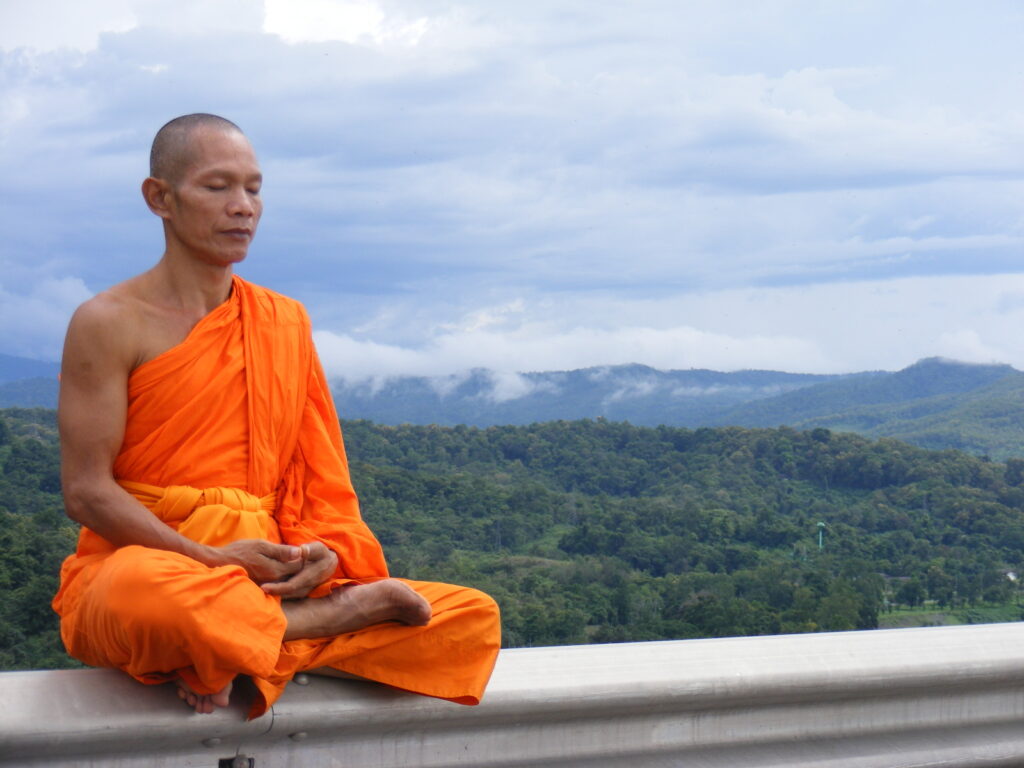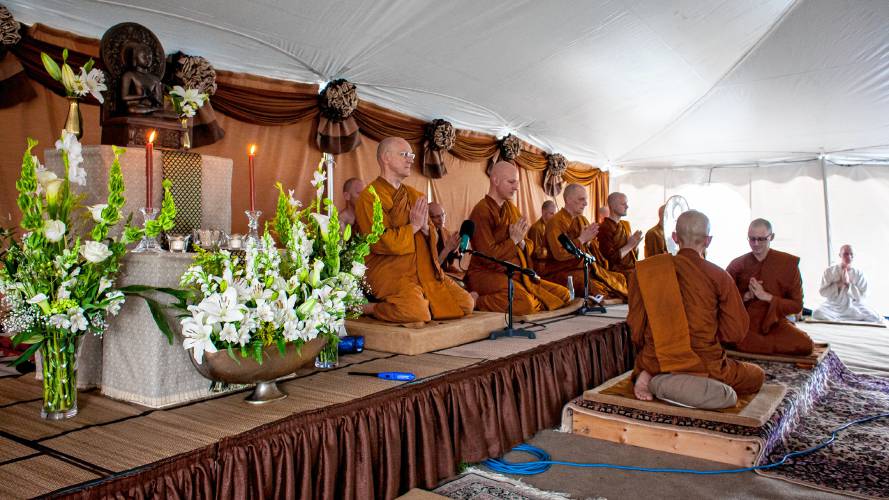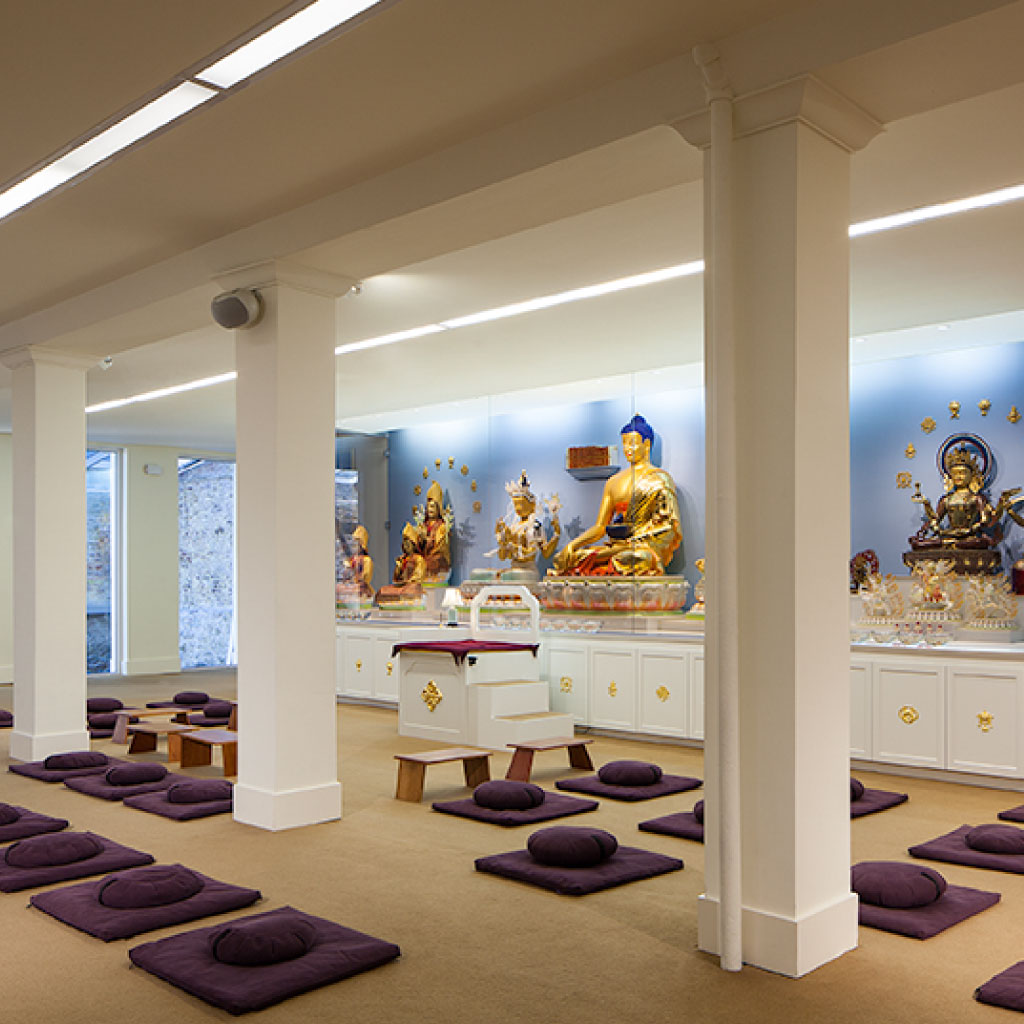Putting Buddhism Back in Buddhist Meditation
A new generation of Buddhist centers and teachers are emphasizing that meditation is more than just a way to relax, recharge, or feel centered in oneself

(Phra Ajan Jerapunyo-Abbot of Watkungtaphao. Image source: Wikipedia Commons)
Last year Sam Greenberg, 32, took a two-month sabbatical from work with his boyfriend, Hillel Friedman, 29. As he waited for takeoff to their trip’s first location, he decided to look up meditation retreats.
“One of my goals for the sabbatical was to really recharge and relax after all the craziness of COVID, and working through all that time,” said Greenberg, who had participated in a meditation retreat once before, and generally believes his life would be better with more meditation and mindfulness built in. “And so we had been thinking for a while of doing some kind of meditation retreat while we were traveling.”
The two used their last moment of ground contact to find an upcoming program, advertised as a men-only retreat to celebrate joy and beauty, hosted by a Buddhist center. They signed up.
“Pretty quickly it began to dawn on us that what we thought was a meditation retreat for people of all backgrounds was actually a pretty serious Buddhist religious experience,” said Greenberg, describing how the two were picked up from the train station by a community member who immediately asked about their Buddhist practice, as well as what Buddhist communities they were involved with back home. On site, the sessions included offerings to Buddha statues and lectures on Buddhist beliefs. “We read the website and interpreted it as being something that did not require a deep commitment to Buddhism. And I think when we showed up, we were kind of surprised to find out that it was.”
Any Google search for “Buddhist meditation retreats” invariably turns up scores of programs promoting practices associated with Buddhism, but few teach these practices within a Buddhist traditional path. Most offer massages and facials, not sessions on comprehending the Four Noble truths.
As meditation and silent retreats became more popular in secular contexts – the wellness tourist industry has exploded in the past decade, and only become more mainstream in a post-COVID world – a new generation of Buddhist centers and teachers in the U.S. find themselves wanting to emphasize that meditation can be more than just a way to relax, recharge, or feel more centered in oneself.
But combatting decades of popular conception can be an uphill battle.
“Sometimes, it’s like everyone who comes here or gets in touch with me seems to already have an idea or a concept of what meditation is and what it will do for them,” said the Rev. Hugh Gould, who was ordained as a Buddhist monk in the Soto Zen tradition in 1988 and serves as the resident teacher and monk of the Eugene Buddhist Priory in Eugene, OR. “And they are often talking about how anxious they are, or dealing with nervousness and anxiety in their lives. Which, given what’s going on in the world, of course. But one of the things that I find most unfortunate is that people come to think this is what meditation is for.”
Situated near the University of Oregon, Gould often finds himself confronting assumptions about the purpose of meditation from students, many of whom have never been taught to see Buddhism as its own religious tradition.
“It is often students who come here thinking about it through that prism of therapy, or ‘I want to understand myself better,” he said. “They’ve heard that meditation can be useful or something. And then when they come on a Sunday, it’s very clear to them that this is a religious practice, and I’d say nine times out of 10, I don’t see them again.”
The Temple Forest Monastery in Temple, New Hampshire, where thirteen ordained monks in the Thai Forest tradition, and five novices, occupy several acres of land, has become more emphatic in how they advertise their retreats.

(Temple Forest Monastery. Photo by Elizabeth Frantz for the Concord Monitor)
“The Temple Forest Monastery is not a retreat or meditation center, but a monastery devoted to training monks in the Forest Tradition of Theravada Buddhism,” the website reads, detailing how visitors are expected to follow the Eight Precepts of Buddhism, and keep the monastic schedule: 5:00 AM group meditation, no eating from 12:00 PM lunch until 7:00 AM breakfast, and doing their share of chores.
Theravada is one of the major schools of Buddhist practice, rooted in the texts of the Pali canon, and includes the Thai Forest tradition, Burmese Buddhism, and other lineages. While all Buddhist traditions accept certain precepts, each lineage has its own emphasis and teachings, and each major school has its own focus. Theravada Buddhist traditions believe monastic practice is required to achieve enlightenment, and focus more heavily on attaining enlightenment, or liberating oneself from the cycle of death and rebirth. Mahayana Buddhism, another major school associated with the traditions of China, India, and Japan, among others, believes a layperson can achieve such a state, but with much more difficulty, and places more value on persisting in reincarnated states. All traditions accept that attachment leads to suffering, and to liberate oneself from want, or attachment, reduces suffering, as does accepting the impermanence of all things. Cultural, geographic, and theological differences lead to distinctions in how to get to such a state.
This diversity can make it hard to define the modern Buddhist tradition that has developed in the West, since there is no one set of practices or beliefs all Buddhists share.
“The thing to remember is Buddhism is a collective noun for many, many, many different forms of practice and teachings and experience and ritual over the course of more than 2,000 years, in many different cultural and geographical settings with many different languages.” said Evan Thompson, a philosopher who has written widely on Buddhism and teaches at the University of British Columbia. “So there’s no way to just use the word Buddhism and make it refer unequivocally to one thing.”
It can be a particularly intricate discussion for White Buddhist practitioners, many of whom seek teachers and training in the Asian countries which originated their particular lineage of Buddhist practice.
“Some Western Buddhist teachers will say ‘you really can’t be a Buddhist in a deep way without embracing the ideas of karma and rebirth,” Thompson said, referencing some of the metaphysical beliefs that underpin some sacred Buddhist texts. “And other Buddhist teachers will say, no you can either be agnostic, or you can actually not accept it and still be committed to a Buddhist way of life. So that’s a debate that happens within the Western Buddhist world. It was seen as something that could be understood or interpreted in a more psychological way rather than a metaphysical way.”
Even meditation itself, Thompson emphasized, was not always standard practice, despite its ubiquitous association with Buddhism today in the West.
For much of its history, meditation was seen in Buddhist traditions as a tool for monks and nuns alone, and far too dangerous for a layperson to take up without proper training. Meditation was not about relaxing or destressing after a packed work day, but a tool for achieving enlightenment. This required developing one’s comprehension of the Buddha’s teachings, and accepting some core Buddhist beliefs, including the idea that experience is suffering, or dukkah, and only overcoming attachment to the material world can free one from the cycle of death and birth.
In traditional Buddhist understanding, meditation is not meant to hone one’s productivity, or even make someone feel more at peace, though it can lead to those things. It can be scary, to accept and realize Buddhist truths about the world, especially without the guidance of a qualified teacher.
“When people come and say ‘I want to calm the mind,’ it is always more than they bargained for,” said Jack DeTar, executive director of Rangjung Yeshe Gomde California, a Buddhist retreat center in northern California, and International Coordinator of Shedrub, a global Buddhist organization, under the guidance of Tibetan Buddhist teacher, Chokyi Nyima Rinpoche. “Because to calm the mind first you have to look at it.”
In fact, an emerging cadre of scientists, such as Jared Lindahl at the Varieties of Contemplative Experience Project at Brown University, have begun to track adverse mental health responses to meditation among those with no previous mental health issues, coming back to ancient concerns that such practices are tools for enlightenment, not to be undertaken lightly and without training, and definitely not simply relaxing experiences. A 2021 feature story in Harper’s Magazine chronicled these studies, bringing new attention to the cases of people who had negative mental experiences with “unlocking their minds.”
The narrow use of meditation began to change in the 19th century, when meditation become a form of cultural resistance in many Southeast Asian countries, taken up by the laity of newly colonized countries such as Burma and Thailand to demonstrate pride in their heritage. The practice grew alongside developing discourse among Buddhist populations, aimed at British colonizers, which strove to explain Buddhism through the prism of Protestant values. This Buddhist discourse, proudly defined as counter to dogmatic Western religions but explained in the very language and values of those cultures, set the stage for its spread in the West as a counter-cultural spiritual practice.
In the 1960s, following a century of increased trade with Asia and newly revamped immigration policies (as well as ongoing intrigue in Hinduism), Western-oriented thinkers began to package and spread Buddhist teachings across the United States more widely, as part of a new mindfulness movement. Leaders like Jon Kabat-Zinn, famous for his stress reduction techniques and numerous books on mindfulness, believed Buddhist practices like those he learned from the Zen tradition would help people overcome suffering, but he knew they needed to be shorn of their religious origins and promoted as a form of mental health to be accessible to Americans. Around this time, beloved Vietnamese monk, activist, and leader Thich Nhat Hanh began to promote his vision of engaged Buddhism, publishing wildly popular books on how Buddhism can change people’s lives. As such trends took off, Buddhist practices began to meld with the medical profession and the messages of life coaches, wellness gurus, and others who saw them as the ideal way to optimize one’s life. It became the refuge of those looking to be spiritual but not practice the Christianity or Judaism they associated with conservative, restrictive ideas. The original goals of liberating oneself from want, and the dangers of such pursuits when done right, fell to the wayside.

(Kadampa Meditation Centert)
Today, one of the more well-known meditation practices is Vipassana, developed in Burma. Known for its austere and challenging demands, it is often practiced by non-Buddhists, and particularly beloved by Silicon Valley tech nerds and anyone who fancies themselves to be “intense.” Though emergent from Burmese Buddhism, it has become more about testing one’s limits, spreading alongside renewed interest in stoicism and physical feats of endurance. When Jack Dorsey, then CEO of Twitter, tweeted about his 10 day Vipassana retreat, it opened up new debates about the value of such experiences. But the appeal of Buddhist-based practices is only growing stronger: Meditation apps like Calm, Headspace, and others saw a collective increase of 2 million subscribers in the U.S. in the first two months of the pandemic alone, and “meditation pods” have begun to dot the wellness initiatives of top companies. More and more people are meditating, but not with the traditionally Buddhist goal of uprooting suffering by comprehending the Four Noble Truths, among others.
Many within the Buddhist community see this tradeoff – widespread popularity for loss of Buddhist particularism – as no longer maximizing the good Buddhist teachings can offer the world.
“From the Buddhist perspective, anything that helps reducing suffering in someone’s experience is good, so if these apps are helping people, that’s wonderful,” said Jack DeTar. “But there is a deeply powerful and significant experience of liberation that can occur as a result of the path under the guidance of a qualified teacher.”
Ajahn Cunda, based at Abhayagiri Monastery in northern California, a community in the Thai Forest Tradition of Ajahn Chah, emphasizes this point when he considers what it would mean for more people in the U.S. to reflect on the goals of meditation. “If we’re aiming at trying to ‘get something’ from meditation to make our lives easier, we’re just caught right back in the cycle of desires, filled with dukkha, or suffering, and not wanting to annihilate our whole selves,” he said.
Increasingly, Cunda finds that some of the people who visit the monastery have different goals in mind than what the Buddha originally prescribed for liberation. The goal of Buddhist practice, he explains, is ultimately to end the suffering and stress inherent to the cycle of birth and death. This comes about through the relinquishment of unwholesome desire and unwholesome practices through the Noble Eightfold Path, and to gain insight into the Four Noble Truths. “A problem some people have with meditation,” he says, “is believing the experience should be peaceful. But it can be difficult and unpleasant, at first.”
This is a new way of presenting itself for a tradition which is only recently reclaiming its religious framework, at a time when monasteries across traditions are finding their secular appeal to be newly valuable. Catholic monasteries and Christian retreat centers are likewise overrun with interest for silent stays and contemplative retreats, many from people who are not Christian, and not interested in deepening their relationship to Christ, but simply looking for a place to gather their minds. Popular books, such as Tibetian Buddhist master Dzongsar Jamyang Khyentse’s 2008 What Makes You N0T A Buddhist, buck this trend of universalizing religious teachings, instead demonstrating the new instinct among some Buddhists to emphasize their particularism.
And many hope that people will realize being thrust from their comfort zone is not always bad. Greenberg, the retreat-goer, recalled how he had likewise been taken by surprise by his first silent retreat experience. “I definitely would not have gone had I known what I signed up for, because the idea of being mostly silent for a week is pretty terrifying, I think, to a lot of people,” he recalled. “In the end, I was so happy I did it. I just emerged so much calmer and more centered from that week. And that’s what sort of made me excited to try to do this again.”
While some want to ride the wave of popularity, many are excited to see who it will bring them.
Shira Telushkin writes on religion, art, culture, and the human search for meaning. Her work has appeared in The New York Times, The Atlantic, The Washington Post, and many other publications. She teaches religion reporting at the Newmark Journalism School at CUNY.